Installation of fans on the roof: features of the installation and fastening of roof fans
Air cleanliness in residential, workrooms is extremely necessary. Agree, the musty atmosphere in the house is very unpleasant. However, the change in air volume is achieved not only by the influx of air, but also by its removal from the walls of the building. And with the last task, exhaust ventilation systems often can not cope.
Modern buildings, whether it is multi-level office complexes, residential facilities, sports complexes or industrial workshops, consist of spacious, high-ceilinged rooms. For regular replacement of air in them, a forced exhaust is required by several roof-mounted ventilation devices of the installation type.
We will tell you how ventilation equipment is selected, how the fans are mounted on the roof, and why it is impossible to do without a glass.
The content of the article:
Roof Fan Features
These appliances are for roof mounting only. They are most effective in systems forced ventilation large area facilities. By installing roof fans on the building with or without integration into the duct system (for example, above the airport hall), it will be possible to solve the problem of removing contaminated air.
Air handling units are able to remove smoky, exhausted (with impurities, unpleasant odors), gassed and saturated air from the large-sized premises. The use of roof fans is possible for both aboveground and some underground facilities.
Ventilation devices placed on buildings, depending on the method of capturing and venting air, are divided into axial, radial and diagonal.
Types of ventilation structures
Axial fans They combine simplicity of design, reliable performance and easy maintenance.Structural endurance allows them to be used equally efficiently for both air exchange and when creating smoke-free ventilation, as well as for air back-up in a fire (work at an air flow temperature of over 400aboutWITH).
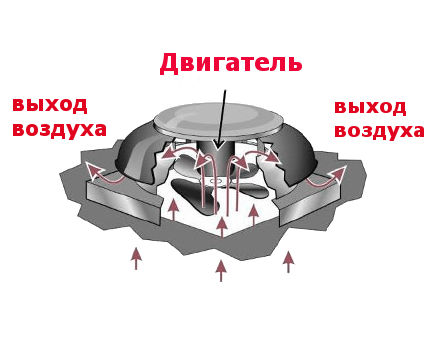
The devices are highly resistant to chemical compounds in the composition of the removed air, which allows mounting axial fans on the roof of industrial facilities in the pharmaceutical and chemical fields of activity.
This group includes most household fans: channel devices, devices installed in wall supply and exhaust valves, bathroom fanscombined and separate bathrooms.
Radial fans. For these ventilation devices, a snail case is characteristic, directing air at a right angle to the impeller with centrifugal rotation. They can pump air volumes containing mechanical pollutants in concentrations up to 100 mg / m3, regularly remove air even in strong winds.
The characteristic structure of the blades provides the device with high performance, but also high noise. Therefore, radial roof fans are mainly used in industrial facilities. The temperature of the air pumped out by the radial device must be less than 80aboutWITH.
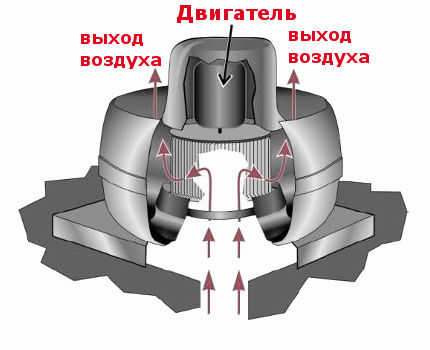
Diagonal fans. These ventilation devices are a combination between axial and radial models. Their suction impeller takes air in the axial direction, and deflects it by 45 before the airflowabout. This gives an increase in power due to the centrifugal force characteristic of radial fans.
The combination of the qualities of axial and radial roof ventilation units provides diagonal efficiency models up to 80%. With sufficient power, radial roof fans are relatively compact and quiet.
Flat Reinforced Roof Aisle Units
The output of ventilation channels through the layers of the roofing “pie” of flat roofs is possible only when using a special technical unit for the passage of the roof.
This structural element compensates for dynamic and static loads exerted by a working ventilation device. Also, a ready-made passage unit simplifies waterproofing work in the ventilation outlet sector.
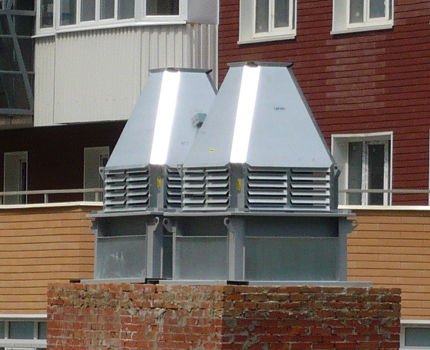
On reinforced concrete upper floors, assembled from slabs or poured into formwork using corrugated board, the passage units can be laid out of brick, formed by a strip foundation or concrete casting. Outwardly, it looks like a ventilation shaft raised above the roof level, on the headband of which a fan is mounted.
However, such a design of the passage assembly is ineffective, since it creates difficulties with mounting fans and a lot of difficulties with waterproofing adjacent sections.
Reinforced ventilation system can be mounted on reinforced concrete floors with a reinforced concrete passage unit, which is an improved version of the Soviet ST series. This product consists of two reinforced concrete shells (glasses) - a cylindrical internal and a four- or six-sided external parallelepiped.
The reference is the outer glass. Thanks to its faces, it is easy to waterproof it along the perimeter of the junction with the main roof covered with a rolled carpet. The round tube shaped as a round pipe is covered with heat insulation from the outside.The outer cup of the roof aisle assembly is equipped with monolithic anchor fasteners with reinforced concrete base of the roof and with a roof fan.
It is permissible to install reinforced concrete double-hull glasses on floors and gently sloping slopes with high bearing capacity with a slope of up to 12about. It is required to choose a model that meets not only the parameters of the roof fan, but also with a slope of the bottom equal to the actual slope of the roof. The mass of the double-case reinforced concrete node of the roof passage is over 300 kg.
Installation of reinforced concrete glass
Before lifting the cup assembly of the passage to the roof, the visible metal elements and welds on the reinforced concrete product must be prepared - cleaned, coated with primer, then painted in two layers with an anti-corrosion compound. The outer surface of the outer shell should be puttied, apply weather-resistant paint.
To lift a massive glass (about 300 kg) on the roof, slings and a truck crane are needed. Exposing the outer shell of the glass to the mounting location should be performed on the M200 cement-sand mortar.
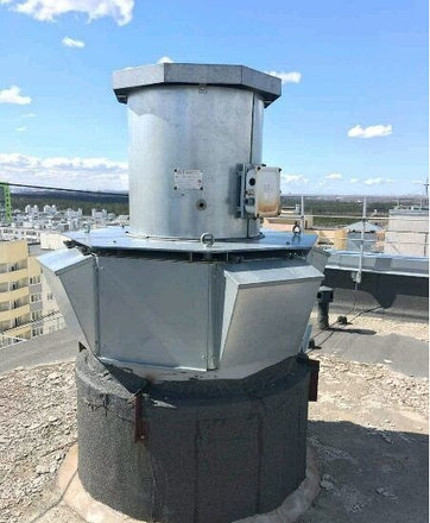
Anchoring reinforced concrete cans to the floor slab is carried out with the installation of embedded parts. If fastening is carried out to a bearing roofing layer of reinforced concrete slabs, it is better to make through installation of the glass by installing tie rod reinforcing bolts in the joints between the slabs.
Near the walls of the base of the installed glass, an inclined screed is made with M150 solution. To insulate the perimeter near the node of the passage of the roof, a mineral wool plate is placed under the screed. A layer of waterproofing roll materials is deposited over the screed.
Along the junction of waterproofing materials with a glass, their edges are lapped onto its walls, closed with an apron of galvanized steel and fixed with galvanized dowels. The seam along the line of abutment of the apron to the walls of the reinforced concrete glass is filled with sealant (polyurethane, thiokol).
Installing a roof fan in a reinforced concrete glass
Roof fans are embedded in monolithic and slab reinforced concrete floors of industrial facilities using typical double-shell reinforced concrete glasses with an inner diameter of 700 to 1450 mm and a height of 400 mm.
Recall that before mounting the fan, the glass should become a constructive part of the reinforced concrete slab of the roof.

To fix the fan, mortar anchor bolts are monolithic in the upper part of the reinforced concrete cup with cement-sand mortar, and in the lower part are the tubes through which the bolts for fastening the fan tray are passed. After preparing the anchor fasteners, a slope from the M150 solution is created along the top of the glass.
Before installation, a revision of the design of the fan and its electric motor is carried out. The clearance between the shell (or inlet) and the impeller is checked.
Then, a check valve is attached to the branch pipe of the roof fan, which automatically opens during the operation of the ventilation unit and overlaps the section of the branch pipe when it is turned off.
If according to the project, a duct network is connected to the fan, the branch pipe (first link) should be connected to the ventilation unit before its installation in the reinforced concrete can. Ducts are fixed on building structures, their weight should not affect the ventilation device.
Installation sequence
Given the massiveness of the ventilation device, it must be handled very carefully.
The installation procedure is as follows:
- The fan is manually set above the glass using a truck crane or using jacks. The vibration-isolating part of the fan is fixed (if the device is equipped with it) with standard bushings and locking bolts;
- The fan is installed on a glass, on the head of which a rubber gasket is placed. Anchor bolts are inserted into the holes of the mounting flange;
- The horizontal position of the device is verified by level. Mounted visor. Nuts and locknuts are screwed onto anchor bolts;
- The gap between the top of the glass and the shell (or pipe) of the ventilation device is filled with construction sealant.
At the end of the installation, the stroke of the self-opening valve is counterbalanced. From vibration isolators (if any) on the roof fan, bushings and retaining bolts that previously fixed vibration isolating elements during transportation of the device are removed.
The power supply is connected, the strength of the connection and the free rotation of the impeller are evaluated, then the correctness of its rotation at startup (in the direction of the arrow).
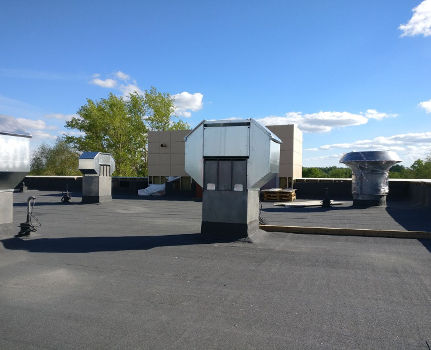
We emphasize that the placement of a condensate pan in the cold months is mandatory. The drain of collected moisture is provided by a drainage pipe with a diameter of 15-20 mm, connected to the coupling at the bottom of the pallet.
Universal nodes of the passage of the roof
These glasses are prefabricated steel structures from a welded square body and front panels with a height of 400 mm. These nodes of the passage can be used both on hard and soft roofs, and with any type of roofing.
Universal metal cups can be equipped with ventilation systems when placed on roofs with a slope of up to 30about.
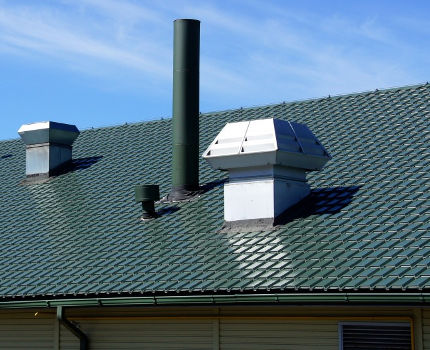
Base plates located at the top and bottom of the glass are made of 10 mm steel sheet. Additional reinforcement is provided by stiffeners made on the base plates. The structural elements of the product are connected by electric welding, the thickness of the seam is at least 6 mm.
The body of the steel roofing unit of the passage is mounted on the base of channels, fixed to the supporting elements of the roof. In the upper part of the body there are welded studs, whose positions coincide with the mounting holes on the fan base.
Double walls of the glass with a thickness of 10 and 12 mm contain thermo-noise insulation material. Models without insulation inside the walls are also available. By the way, when equipping a building with a smoke exhaust fan, a metal cup, in addition to increased fire resistance, may require additional external thermal insulation.
A flap valve or an insulated valve equipped with an electric actuator can be installed in the body of the steel cup. To the duct of the lower part of the node of the passage of the roof are connected to the condensate pan and grille, or the outlet part of the duct.
The specifics of using a metal cup
The principle of mounting the steel node of the passage of the roof on a rigid roof is almost identical to the order of installation of the reinforced concrete cup. Consider the features of assembling a metal cup on a soft roof.
If a metal cup is equippedcheck valve, then the latter must be mounted before installing the passage assembly in place. There may be transport bolt locks on the valve - they must be removed. Note that when you try to set the valve on the installed glass, most likely it will be skewed.
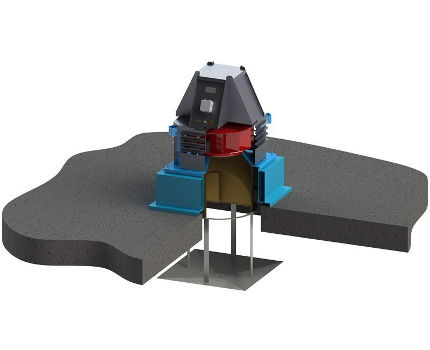
Installation of the product is carried out on an opening prepared in the roof, corresponding to the dimensions of the inner section of the glass. It is fixed with anchor bolts on the bearing part of the roof, or another bearing support, capable of holding it and securing it in position. The aisle assembly is always set upright!
Final sealing, namely, a cement-sand screed of the mounting base of the glass, laying out the thermal insulation layers, placement on the contour of skirts and aprons made of galvanized steel and crimp clamps, is carried out according to actual conditions at the installation site of the metal passage aisle (roof structure, location and material of the support, etc. .).
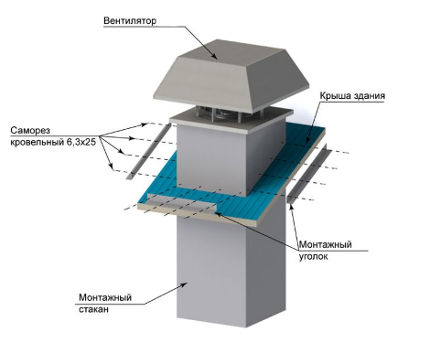
Before mounting the fan on the cup, it is necessary to fix the pallet, having prepared 14 mm holes for bolted joints on its side walls.
Installation of a roof fan to a metal cup is carried out with the device mounted on studs with nuts and washers. Having completed the installation, it remains to close the contour of the gap between the fan and the glass with construction sealant.
The horizontalness of the fan is verified by the level, this is mandatory. The distortions allowed during installation work will damage the operation of the ventilation unit and reduce its service.
Conclusions and useful video on the topic
Installation sequence on a hard roof and the principle of a radial fan:
In what order is the roof fan installed on a soft roof:
Roof ventilation systems are designed for long service life with minimal maintenance. However, they still need some maintenance: checking the strength of the joints (riveted, bolted, welded), examining the condition of the paintwork of the flow zone of the fan and the blades on the impeller, and removing dust and dirt.
Therefore, the equipment on the roof should be freely accessible in the form of protected tracks, so as not to damage the “pie” of the roof, especially soft. For this purpose, rolled mats made of plastic or rubber are suitable.
Do you have useful information on the topic of the article? Is there any information worth sharing with site visitors? Please leave comments, ask questions on controversial and obscure points, post photos in the block below.

 Nodes of passage of ventilation exhaust shafts: types, features of the choice, application and installation of penetration
Nodes of passage of ventilation exhaust shafts: types, features of the choice, application and installation of penetration  Types of fans: classification, purpose and principle of their operation
Types of fans: classification, purpose and principle of their operation 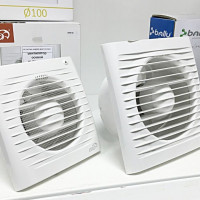 TOP-10 rating of silent fans for a bathroom with a non-return valve
TOP-10 rating of silent fans for a bathroom with a non-return valve  Supply and exhaust ventilation: principle of operation and features of the arrangement
Supply and exhaust ventilation: principle of operation and features of the arrangement  Installing a ventilation fungus on the roof: types and methods of installing a deflector on an exhaust pipe
Installing a ventilation fungus on the roof: types and methods of installing a deflector on an exhaust pipe  Ventilation in the wardrobe: features of the arrangement of the hood in the dressing room and wardrobe
Ventilation in the wardrobe: features of the arrangement of the hood in the dressing room and wardrobe  How much does it cost to connect gas to a private house: the price of organizing gas supply
How much does it cost to connect gas to a private house: the price of organizing gas supply  The best washing machines with dryer: model rating and customer tips
The best washing machines with dryer: model rating and customer tips  What is the color temperature of light and the nuances of choosing the temperature of the lamps to suit your needs
What is the color temperature of light and the nuances of choosing the temperature of the lamps to suit your needs  Replacement of a geyser in an apartment: replacement paperwork + basic norms and requirements
Replacement of a geyser in an apartment: replacement paperwork + basic norms and requirements